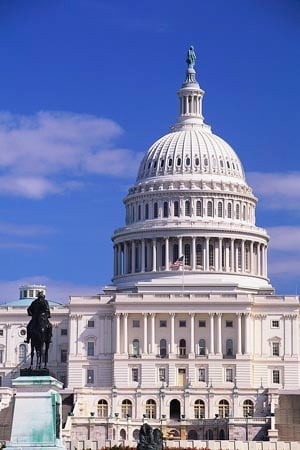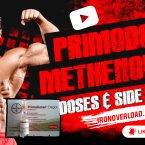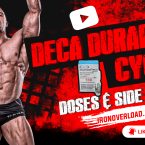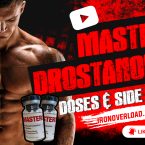Sign up to Get FREE Steroids, SARMS, Peptides eBooks
My friend and EF Platinum Member Rick Collins, JD, is the lawyer that members of the bodybuilding community and nutritional supplement industry turn to when they need legal help or representation. He and his firm represent dietary supplement companies nationwide, and he has personally defended steroid criminal charges from coast to coast. This week, he shares with us his recent article “The New Designer Steroid Bill and YOU.” This is a sad day for bodybuilding and the dietary supplement industry. Read on...
Q: What is the “Designer Anabolic Steroid Control Act of 2012”?

A:
It’s a Senate Bill (SB 3431) introduced by Senators Orrin Hatch (R-Utah) and Sheldon Whitehouse (D-R.I.) and referred to the Judiciary Committee. If passed by Congress, it will amend the Controlled Substances Act to more aggressively regulate steroidal substances being sold as dietary supplement ingredients. The clear intent is to remove remaining “prohormone” products from the market and prevent new ones from being introduced. The bill would take such past or present supplement products as ATD, 6-oxo, 6-bromo, Furazadrol, Halodrol, Havoc, and Tren and legally classify them as anabolic steroids and Controlled Substances. Here’s what Sen. Whitehouse said in introducing the bill on July 25th, 2012:
“… I am pleased to join Senator Hatch in introducing the bipartisan Designer Anabolic Steroid Control Act of 2012. This measure will help keep American children and families safe from dangerous designer drugs that masquerade as healthy dietary supplements. This legislation is based on Senator Specter’s work in the previous Congress, and I thank him for his leadership on this issue.
Doctors and scientists have long recognized the health hazards of non-medical use of anabolic steroids. For that reason, Congress has previously acted to ensure that these drugs are listed as controlled substances. Nonetheless, according to investigative reporting and Congressional testimony, a loophole in current law allows for designer anabolic steroids to easily be found on the Internet, in gyms, and even in retail stores.
Designer steroids are produced by reverse engineering existing illegal steroids and then slightly modifying the chemical composition, so that the resulting product is not on the Drug Enforcement Administration’s, DEA, list of controlled substances. When taken by consumers, designer steroids can cause serious medical consequences, including liver injury and increased risk of heart attack and stroke. They may also lead to psychological effects such as aggression, hostility, and addiction.
These designer products can be even more dangerous than traditional steroids because they are often untested, produced from overseas raw materials, and manufactured without quality controls. As one witness testified at a Crime Subcommittee hearing in the last Congress, ‘all it takes to cash in on the storefront steroid craze is a credit card to import raw products from China or India where most of the raw ingredients come from, the ability to pour powders into a bottle or pill and a printer to create shiny, glossy labels.’
The unscrupulous actors responsible for manufacturing and selling these products often market them with misleading and inaccurate labels. That can cause consumers who are looking for a healthy supplement--not just elite athletes, but also high school students, law enforcement personnel, and mainstream Americans--to be deceived into taking these dangerous products.
Loopholes in existing law allow these dangerous designer steroids to evade regulation. Under current law, in order to classify new substances as steroids, the DEA must complete a burdensome and time-consuming series of chemical and pharmacological testing. As a DEA official testified before Congress: ‘in the time that it takes DEA to administratively schedule an anabolic steroid used in a dietary supplement product, several new products can enter the market to take the place of those products.’'
The Designer Anabolic Steroid Control Act of 2012 would quickly protect consumers from these dangerous products. First, it would immediately place 27 known designer anabolic steroids on the list of controlled substances. Second, it would grant the DEA authority to temporarily schedule new designer steroids on the controlled substances list, so that if bad actors develop new variations, these products can be removed from the market. Third, it would create new penalties for importing, manufacturing, or distributing anabolic steroid’s [sic] under false labels.
Senator Hatch and I have worked closely with a range of consumer and industry organizations to ensure that this legislation would not interfere with consumers’ access to legitimate dietary supplements. I am pleased that the measure has been endorsed by the United States Anti-Doping Agency, the Alliance for Natural Health, the Council for Responsible Nutrition, the American Herbal Products Association, the Natural Products Association, the Consumer Health Products Association, and the United Natural Products Alliance.
I thank these organizations for their support, and look forward to working with them, with Senator Hatch, and with colleagues from both sides of the aisle to enact this common sense measure into law.”
Q: Is the bill specific in naming the substances to be added to the list of anabolic steroids?
A: The “Discussion Draft” of the bill that I reviewed would specifically add 27 chemical compounds to the list of substances defined as anabolic steroids in Title 21 of the U.S. Code [21 USC 802(41)]. The bill presents the chemical nomenclature for these substances. Some of the chemical names listed, according to steroidal supplement guru Patrick Arnold, contain errors or refer to compounds that may actually not exist. But any minor mistakes aside, it seems that the drafters of the bill extensively canvassed the supplement market and perhaps even the Internet message boards in an effort to identify and specifically name as many compounds as possible. This isn’t the first time that Congress has expanded the list of anabolic steroids. The original list, compiled in 1990, was amended in 2004 to include androstenedione and a variety of other steroidal products. The DEA later issued a Final Rule (//www.gpo.gov/fdsys/pkg/FR-2009-12-04/pdf/E9-28572.pdf), effective January 2010, classifying three more compounds as anabolic steroids (boldione, desoxymethyltestosterone, and 19-nor-4,9(10)-androstadienedione, along with their salts, esters and ethers). Then the DEA last year published a notice of proposed rulemaking to add yet two more steroidal compounds, prostanozol and methasterone (marketed as Superdrol), along with their salts, esters and ethers, to the list. The Final Rule on these two was issued on July 30th, 2012 (//www.gpo.gov/fdsys/pkg/FR-2012-07-30/pdf/2012-18495.pdf), effective August 29th, 2012. This new bill just follows up by adding a whole bunch more (although now a moot point, it includes the recently scheduled prostanozol and Superdrol) … and by design, misses very few.
Q: What about steroidal substances that are not on the list?
A: The bill changes the way unlisted steroidal compounds are dealt with. It says that “a drug or hormonal substance (other than estrogens, progestins, corticosteroids, and dehydroepiandrosterone) that is not listed … and is derived from, or has a chemical structure substantially similar to, 1 or more [listed] anabolic steroids [is considered an anabolic steroid] if … [it] has been created or manufactured with the intent of [promoting muscle growth or having pharmacological effects like testosterone or] has been, or is intended to be, marketed or otherwise promoted [to suggest it will promote muscle growth or have pharmacological effects like testosterone]. Notice that there’s no proof requirement that the substance actually promote muscle growth or act like testosterone pharmacologically – only that it’s created, manufactured, marketed or promoted with the intent of doing so. So, for supplement industry purposes, a company that markets any product that is derived from or has substantial chemical similarity to a listed anabolic steroid and is also created or marketed to build muscle or have a pharmacological effect like testosterone is marketing an anabolic steroid. An interesting question arises in the following theoretical scenario: Company A markets an ingredient derived from a listed anabolic steroid for health and wellness purposes, and the ingredient has neither anabolic nor androgenic effects. Company B markets the same ingredient but makes the claim, falsely, that the ingredient builds muscle. If Company B is prosecuted and convicted for marketing the ingredient as an anabolic steroid, where does this leave Company A? While it would seem reasonable that the ingredient is an anabolic steroid only with respect to Company B, the issue is not addressed in the language of the bill.
Q: Are there any exemptions provided in the bill?
A: Yes. Unlisted steroidal compounds that are herbs or botanicals are exempted. So are concentrates, metabolites, and extracts of an herb or botanical, or a constituent isolated directly from an herb or botanical. This provision was drafted as an acknowledgement to the current position of the Food and Drug Administration (FDA) articulated with respect to New Dietary Ingredients (NDI’s): that a compound is a “constituent” of a botanical only if it is isolated directly from it, and not if it is instead synthetically created in a lab. The bill further connects the Controlled Substances Act with the Dietary Supplement Health and Education Act (“DSHEA,” a part of the Food, Drug, and Cosmetic Act) by requiring that any exempted substance must be a “dietary ingredient” under DSHEA. And the bill puts the burden of DSHEA compliance on the marketer, by providing that anyone “claiming the benefit of an exemption [has] the burden of going forward with the evidence.” In other words, somebody arrested for selling an anabolic steroid whose defense is that it is an exempted constituent would have the burden of showing evidence of DSHEA compliance.
Q: Does the bill make it easier to add new unlisted substances to the list?
A: It does, by amending a different section of Title 21 [21 USC 811] to provide a fast-track for scheduling. The Attorney General may issue a temporary order, to take effect 30 days after publication, adding a substance to the list if it meets certain criteria. The temporary order “is not subject to judicial review” and a permanent order could be simultaneously sought. But the bill also provides that an unlisted steroidal substance can be considered an anabolic steroid if it’s determined to meet the criteria of an anabolic steroid “in any criminal, civil, or administrative proceeding arising under this Act.” So, while the Attorney General has the power to declare substances to be anabolic steroids through the rulemaking process, unlisted substances can nevertheless be considered to be anabolic steroids without prior rulemaking notice if it’s proven in a court of law, such as during a criminal prosecution of a supplement company or its principals. But the bill also makes it easier for the Attorney General to add new compounds because it changes the criteria and tosses out the rigorous scientific inquiry currently required.
Q: How would the criteria for administrative action change under the proposed new law?
A: Under current requirements, the DEA has to extensively examine peer-reviewed published literature and sometimes even undertake its own pharmacological assay studies to determine if a compound has androgenic and anabolic activity similar to testosterone. This can be a huge, lengthy, complicated endeavor, and the DEA has been far from wild about it. For example, back in September 2009, Joseph Rannazzisi, Deputy Assistant Administrator at DEA’s Office of Diversion Control, testified before the Crime Subcommittee at the hearing (“Body Building Products and Hidden Steroids: Enforcement Barriers”) referenced this month by Sen. Whitehouse in introducing the bill. Mr. Rannazzisi expressed the hurdles imposed by the current law, citing as an example the difficult process of scheduling boldione, desoxymethyltestosterone, and 19-nor-4,9(10)-androstadienedione which was, at that time, in its final stages. He also testified that a review of three (3) additional compounds – methyldrostanolone (methasterone), prostanozol, and adrenosterone (misspelled adrenostreone in his written statement) – had begun. But although three compounds were reviewed, only two were scheduled. Neither the notice of proposed rulemaking in November 2011 nor the Final Rule issued in July 2012 referenced adrenosterone, a compound sold under the name “11-oxo.” Were there problems proving some aspect of the requirements? We don’t know, and the implications from this are open to debate (note also that the substance is also not listed among the specific compounds in the new bill). In any event, under the new definition of an anabolic steroid, the process for scheduling is much easier. If the compound is derived from, or has a chemical structure substantially similar to a listed anabolic steroids, and it’s not an estrogen, progestin, corticosteroid or DHEA, then it’s considered an anabolic steroid merely if it’s been created or manufactured with the intent of being anabolic or androgenic or if it’s marketed or promoted to suggest that it’s anabolic or androgenic. The new definition offers an enormous reduction in the DEA’s burden to schedule a new steroid.
Q: Weren’t many of these supplement products already illegal under the Food, Drug, and Cosmetic Act?
A: Yes. Many of these substances were synthetically created compounds and did not meet the criteria to be sold as dietary supplements under DSHEA. Since they were not DSHEA compliant, they were unapproved and mislabeled “drugs” and the FDA had the authority to investigate and bring charges for federal prosecution. Until recently, however, many in the supplement industry didn’t understand the criminal penalties for non-DSHEA compliance, or didn’t take the threat seriously. But that has changed since a number of sports nutrition companies were prosecuted for selling prohormone products in the wake of the execution of a search warrant on a distributor’s Boise, Idaho facility back in 2009. Some of the same substances now being added to the list of anabolic steroids under the Controlled Substances Act were already declared illegal drugs under the Food, Drug, and Cosmetic Act (FD&CA) ... and the companies selling them were prosecuted federally and convicted. The new bill, however, gives the DEA – often viewed as more aggressive at enforcement than the FDA – the authority to take action. Also, by classifying these substances under the Controlled Substances Act, the new bill escalates the severity of potential punishments.
Q: What does the bill say about sentences for steroid crimes?
A: The bill directs the United States Sentencing Commission to “review and amend the Federal sentencing guidelines.” The last time Congress directed this, the Commission brought the hammer down and greatly escalated the punishments for steroid trafficking crimes by re-calculating the way steroids were quantified. As of 2006, injectable and oral steroids became quantified for punishment in a 1:1 ratio to other Schedule III drugs, resulting in a twenty-fold measurement increase for injectable steroid units and a whopping fifty-fold increase for oral steroid units. One “unit” of an oral steroid became one pill, tablet or capsule rather than fifty; one unit of a liquid steroid was reduced to .5ml rather than 10ml, and steroids in other forms (“e.g., patch, topical cream, aerosol”) were to be reasonably estimated based on a consideration of 25mg as one unit. We don’t know exactly what the Commission will do if this new bill passes, but the bill specifically directs that for steroid products where dosage cannot be readily ascertained, such as powders or topical creams, that “the sentence shall be determined based on the entire weight of the mixture or substance.” So, a person trafficking a kilogram of pure testosterone powder would be at the same federal sentencing level as the person who was selling a product that contained a small or even trace amount of testosterone.
Q: What does the bill say about the way products are labeled?
A: The bill introduces a whole new theory by which to prosecute these cases by making it a crime to import, export, manufacture, distribute, dispense, sell, offer to sell, or possess with intent to manufacture or sell any anabolic steroid, or any product containing an anabolic steroid, unless it bears a label clearly identifying the anabolic steroid by accepted (IUPAC) nomenclature. This provision would apply to manufacturers who use deceptive or “creative” ingredient labeling to conceal that the product is an anabolic steroid. It would also apply to distributors and retailers who know, intend, or have reasonable cause to believe that the product contains an anabolic steroid. Criminal penalties can be up to 10 years imprisonment and massive fines (up to $2.5 million on corporations). Civil penalties can be up to $500,000 per product violation for importers, exporters, manufacturers and distributors. Even retailers can be hit with a $25,000 penalty per product violation (and each package size, form, or differently labeled item is a separate product).
Q: What impact would this bill have on consumers?
A: The bill would have a huge impact on consumers. While marketing prohormones that are currently illegal under DSHEA and the FD&CA subject the marketers to criminal sanctions, consumers don’t face charges. Simple possession itself is not illegal. All that changes when a compound becomes classified as a controlled substance. By reclassifying these compounds into controlled substances, this bill criminalizes the consumers as well as the marketers (the DEA’s Final Rule on prostanozol and Superdrol, once effective, will do this on those two compounds). Being in simple possession of a compound that is a controlled substance is a federal crime – a federal misdemeanor that carries with it up to a year of incarceration. But it likely won’t stop there. If the bill passes, it’s quite probable that individual states will view what Congress did as an important step in protecting the public, especially children, and will seek to amend their own laws to be consistent with the new federal law. In some states, though, simple possession of an anabolic steroid is a felony, not a misdemeanor, and in those states the simple possession of any of these compounds would be a felony. If states follow suit, a person caught during a car stop with a single capsule of 6-bromo, for example, would be charged with either a misdemeanor or a felony (depending on his or her state’s law). An old bottle of Superdrol sitting in a gym bag would be like illegally having a bottle of Vicodin.
Q: Do you think this bill will achieve the intended purposes of Congress?
A: Unlike the poorly conceived and drafted 2004 amendment to the Anabolic Steroid Control Act, this bill shows an investment of considerable effort and thought. It’s clear that the intent behind it is to eradicate steroidal ingredients from the retail supplement market. This bill has the potential to accomplish that. It even requires the Administrator of the DEA to keep Congress in the loop by reporting to them every 2 years on what new steroids have been scheduled. Of course, the bigger picture is unclear. Will consumer demand for steroidal substances that may build muscle disappear? Or will the reclassification of these items and their removal from the dietary supplement market lead to the creation of a black market for them … or to an increased demand for the traditional pharmaceutical anabolic steroids already on the black market? The realities of demand and supply and our experience with alcohol Prohibition would suggest that legislative efforts like this one don’t entirely eliminate problems but instead may push them underground. Time will tell.
Q: What do you predict for this bill?
A: Senator Hatch is viewed as a stalwart advocate for dietary supplements. So, when he sponsors legislation to restrict the industry, many in Congress will see it as something that sorely needs to be done. The bill has received the overwhelming support of the large industry trade groups and there is no organized opposition. Unless there’s some unexpected curveball tossed out, or Earth is hit by an asteroid, there’s a high likelihood the bill will pass. For future updates and analysis, visit www.supplementcounsel.com and www.steroidlaw.com or follow me on Twitter (@RickCollinsEsq) and at Facebook.com/RickCollinsOnline.
Rick Collins, JD, CSCS [www.rickcollins.com] is the lawyer that members of the bodybuilding community and nutritional supplement industry turn to when they need legal help or representation. He and his firm represent dietary supplement companies nationwide, and he has personally defended steroid criminal charges from coast to coast. He can be reached at 516-294-0300. [© Rick Collins, 2012. All rights reserved. For informational purposes only, not to be construed as legal or medical advice.]





